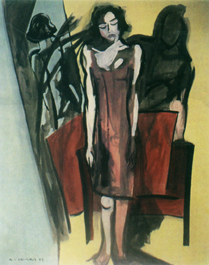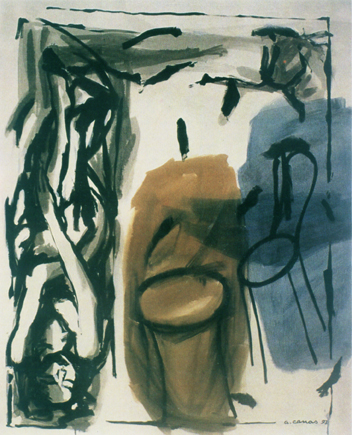
Limits, the discontinuity between a being and the universe around it and the others, is what my painting is all about. I am not contented with a painting which is just a limit between fiction and the world from which it (fiction) is taken.
Lines repeatedly encompass figures while scattered spots represent the world's abstraction against the figure's concreteness or vice-versa. The most important of all is the huge differences in language when one attempts to represent or express what is unattainable and incompatible. What things have that makes them unattainable to each other. Those lines encompassing figures represent nothing obvious. They are nothing but a functional instrument of language, the visualisation of obstacles. The only relationship, if any, is a symbolic one.
It is like the chair which plays the same role of encompassing the solitary person's universe or encompassing the universe in solitude, following and putting it within limits which are near the body's limits. In physical terms, the chair is not much more than the body itself. It steals or takes little more space from the universe. It does not go beyond the body that much. It can, however, act as a symbolic border.
Still the chair. It is a little like clothes, the skin, houses, any sort of shelter. But it is more cruel; more untameable, closer and more restrictive. It is more rigid. When the body is away from the chair the latter represents society, the public, those who watch. As an object the chair has a deontology of its own.
The rules may be slightly changed when the body rests on it. The chair protects the body but only within its limits. The chair is also the seat/place from where one cannot and/or does not want to leave.
In painting, body poses reveal what is essential only marginally even in situations/scenes which are capable of being identifiable with life.
I go back to the beginning - I depict and choose the body's physical poses which seem to be part of a given situation. Situations are the anecdotic sense, the fictional scenario that illustrates and helps to draw the body, hold it and put it in space. They cannot and should not be read literally but as a mere theatre that helps the composition instead. The body's posture is read as a psychological pose and the further one goes from the situation supposedly depicted the deeper the said pose will be. It is also a way of transferring the pathetic to situations, painting's fiction, and protecting the being exhibited.

We are dealing with the soul's solitude, not the body's solitude nor the solitude arising from absence of people. We mean the solitude that cannot be overcome, which is encompassed within the body as a metaphor and within the soul as an unattainable space. In painting the body is used as a means of communication. It is a feasible visualisation, a metaphor.
In this world of redundancy, reducing the means to the possible minimum, repeating somewhat anachronic physical patterns or those with abstract compositions, makes all paintings subtle variations of each other. Figures change as time goes by, they are worn down, become wiser or innocent, gain depth or lightness.
Figurative elements, composing spots or language elements (as in the case of lines), they all bound territories in different ways. It is in that sense that one can speak of formal Minimalism to translate the thematic Minimalism.
These structures arise from knowledge gained after the painting process because inspiration is related only to painting itself and not design. Inspiration and readiness to measure forces, talk, and generate creative acts. Painting arises from the mere act of painting which at its inception is innocent and lacks any sense. It is a very complex process that goes beyond the painting, the series and the painting of time itself. Then a process of mutual knowledge from the painting to the painter and vice-versa is generated. Unlike any other communication act, this process is never bound nor completed.
* Painter. Teacher of Drawing at the Liceu of Macau.
start p. 151
end p.